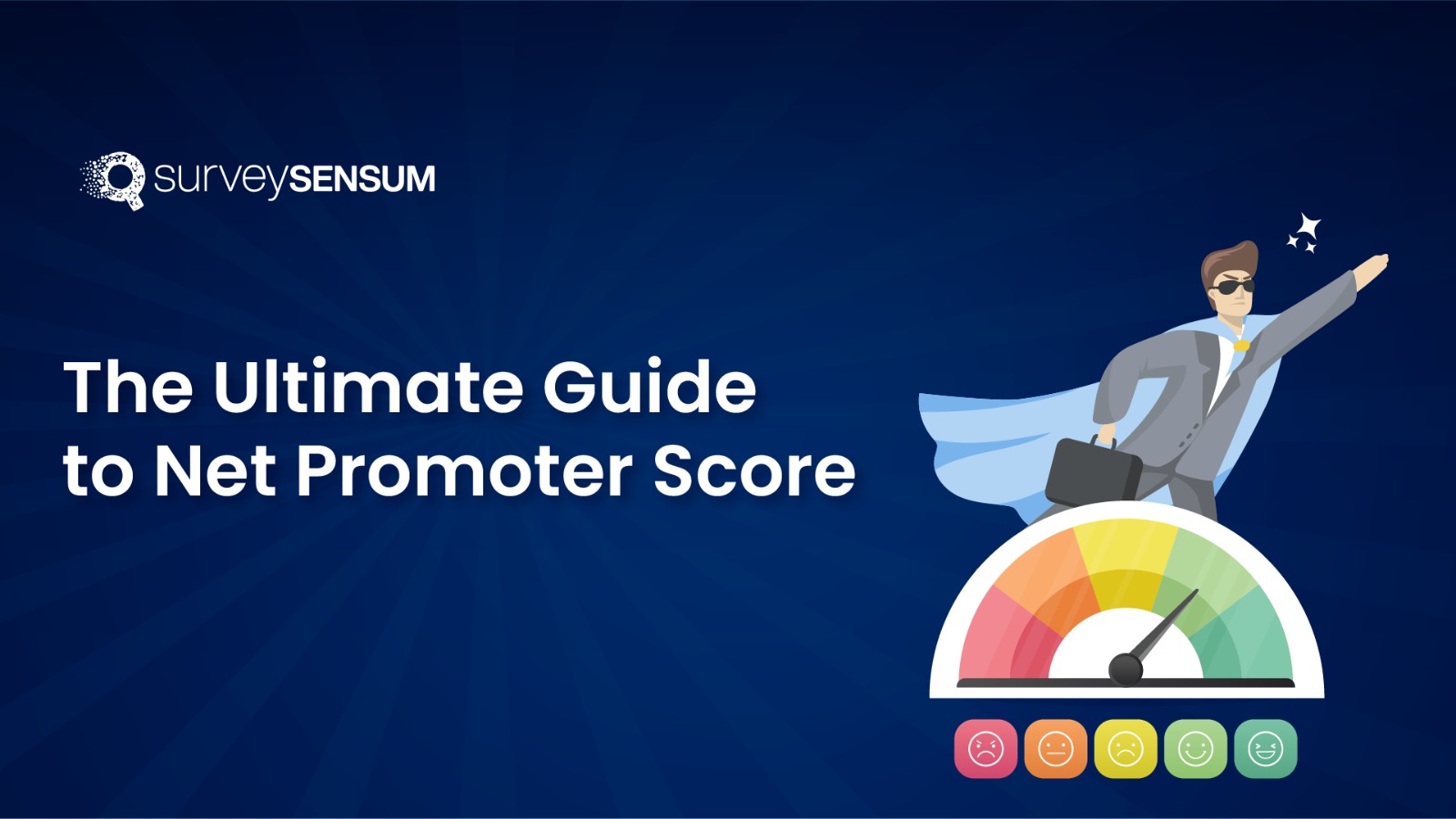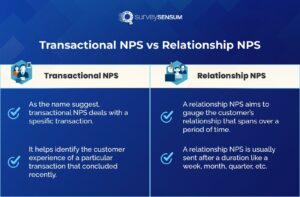Why Customer Experience Is The Real Driver Of Brand Success?
Read More


Net Promoter Score is a CX metric used to measure customer loyalty and satisfaction based on their likelihood to recommend a company’s products or services to others. It is calculated by asking customers a single question –
“On a scale of 0 to 10, how likely are you to recommend [company/product/service] to a friend or colleague?”
Based on their responses, customers are categorized into three groups:
Now that we know what NPS is, let’s understand the different types of NPS surveys.
Running an NPS survey is like scaling the Everest summit.
There are several key aspects to it.
To make the best use of an NPS survey, you must identify the right type of survey to run, the scenario for which the survey will be used, and the question that will provide maximum responses.
Before setting up an NPS survey, you ought to know the various types of surveys that are available at your disposal. The two main types of NPS surveys are:

Surveys conducted to gauge customer loyalty (or their positive relationship) with the brand are referred to as relational surveys.
They ask customers about the overall experience of dealing with the brand, their satisfaction levels, and suggestions for improvement. They are conducted in the frequency of quarterly, half-yearly, or yearly.
Example: An on-demand video streaming service sends a monthly survey requesting feedback about its service quality.
Transactional surveys (tNPS) aim to investigate the customer feedback for each transaction. The primary purpose of this type of survey is to figure out how to improve customer experience.
They are usually sent immediately or within a day or two from the completion of the transaction. Transactional surveys are apt for companies with a limited number of interactions with the customer and hence limited opportunities to seek feedback.
Example: A five-star hotel seeking feedback from a guest who completed a stay recently.
| NOTE: tNPS is useful for businesses in the hospitality industry, but it’s not ideal for businesses that want to measure loyalty and build long-term relationships. Why? Because customers don’t recommend the business after a couple of interactions. |
But now that you know the different types of NPS surveys, let’s understand when to send NPS surveys.
For relationship NPS, it’s best to send surveys at key touchpoints in the customer journey, such as after a significant milestone (e.g., after a certain period of using the product or service, after a major interaction like a support call or purchase).
Let’s understand the different touchpoints for different industries to understand why and when to launch the NPS survey questions.
| Industry | Survey Frequency | Best Time to Send | Why to Send |
| B2B SaaS | Quarterly or bi-annually | Before subscription expiration or contract renewals | To gauge satisfaction with the software, identify areas for improvement, and understand how changes impact customer loyalty |
| B2B Manufacturing | Semi-annually or annually | Before subscription expiration or contract renewals | To assess satisfaction with product quality, delivery timeliness, and overall customer service, and to maintain long-term relationships with clients |
| B2B Marketing & Advertising | After campaigns, projects, or at the end of contracts | After major marketing campaigns to understand the impact of your efforts on client satisfaction | To evaluate the effectiveness of marketing efforts, campaign performance, and client satisfaction with the provided services |
| B2B Fintech | Quarterly or semi-annually | Annually to gauge long-term satisfaction | To understand satisfaction with financial services, assess user experience, and gather feedback on new features or improvements |
| B2B Service | Quarterly or semi-annually | Shortly after service delivery | To assess customer satisfaction with service quality, responsiveness, and professionalism, and identify areas for service improvement |
| B2B Logistics | Quarterly or after major logistics operations | After important shipments or orders | To evaluate service reliability, timeliness, accuracy of deliveries, and communication effectiveness |
| Insurance | Annually | Near policy renewal dates or after significant interactions | To assess customer satisfaction with policy coverage, claims handling, premium rates, and customer service quality |
| Automotive | After every service appointment | After vehicle servicing appointments or dealership visits | To help you understand customer satisfaction levels with the service quality, customer support, and overall dealership experience |
| Telecom | Annually | After service disruptions, or during new service or feature rollouts | To evaluate service reliability, network coverage, call quality, internet speed, and customer support effectiveness |
For transactional NPS, you should send surveys immediately following the transaction or interaction. This ensures that feedback is fresh in the customer’s mind and provides insights into their satisfaction with that particular experience. For example, after a customer completes a purchase, receives a service, or interacts with customer support, sending a transactional NPS survey allows you to gather feedback specific to that interaction.
Now, that you have sent your NPS survey and gathered responses, let’s see how to calculate the NPS score.
Now that you’ve sent the NPS survey and started gathering feedback, it is time to calculate the NPS score.
The general formula for NPS score calculation is as follows.
So, for example, if the responses for 100 survey feedback are as follows
Then your percentages would be 25%, 55%, and 20%, respectively.
Therefore the NPS score would be (25% – 20%), which is +5.
A positive NPS is a good indication. However, a Net Promoter Score of 5 shows that there is plenty of room for improvement. We will discuss this further in the next section.
But is calculating your NPS enough? Your NPS score is not the endgame, what you do with the score is what matters the most. So, gather actionable insights from your NPS feedback and prioritize your action to transform your feedback into revenue with SurveySensum’s top NPS experts!
But the NPS score that you just calculated, is it a good score? Well, let’s understand that.
As a thumb rule, if the NPS score is less than 0, it is a cause for worry as it is a negative NPS score. And an NPS score above 0 is considered okay as it is a positive NPS score, but it still has some further categorization, let’s take a closer look.
Now, the best approach is to identify the NPS scores of your competitors so you know where you stand – which takes us to NPS benchmarking.
NPS benchmarking is the process of comparing the NPS score of a company with its industry standards or competitors. The purpose of benchmarking is to understand your business’s performance with respect to others in the industry.
Here are 8 strong reasons why you should use the NPS Score.

1. NPS helps identify loyal customers who stay with you for a longer time and this helps you increase your retention rate, increasing customer retention rates by 5% can increase profits by 25% to 95%.
2. Loyal customers buy more, spend more, and persuade others to buy from the same business. In fact, acquiring a new customer is 5 to 25 times more expensive than retaining an existing one.
3. Businesses can focus more on retaining loyal customers and offering personalized service. This can help increase CLV.
4. An increase in customer retention rate indicates reduced customer churn.
5. The qualitative feedback you get from the NPS survey can be used to make data-driven decisions in improving your product/service.
6. NPS score acts as an indicator of how well your business is performing. So, if there is a drop in your NPS, you can expect a decline in revenue, sales, and higher customer churn and work accordingly to improve it.
7. The higher the NPS score of a business, the higher the number of customers it has who are likely to recommend it to others.
8. NPS helps identify who your disappointed customers are from the surveys. As a result, you can provide immediate resolution to their issues or problems. In fact, 50% of customers who leave a negative review expect a response within 7 days.
A core focus of business is to keep their customers happy, and NPS is the easiest way to understand how happy the customers are.
Creating an NPS survey can be a time-consuming process, but it doesn’t have to be. With SurveySensum’s industry-specific survey templates, you can create and launch surveys in under 5 minutes!
Now that you know NPS is really important for your customer experience, it’s time to create an NPS survey!
NOTE: An efficient NPS software helps you create lucrative NPS surveys and launch them at the right touchpoint and at the right time. Also, the tool helps share alerts to the team when a detractor shares their feedback and analyzes all the feedback. Not only will it help you close the loop in time, but it will also help you create an efficient NPS program.
You’ve launched the survey and started gathering feedback. It’s time to analyze the NPS feedback.
Now that you have sent the NPS survey at the right time, what should you do with the valuable customer feedback? How can you analyze it?
Here’s what you can do!


Creating, launching, and gathering survey data is not the endgame, you also need to analyze and extract actionable insights from your NPS feedback. But fret not! With SurveySensum’s robust NPS software and a team of top CX experts, you can prioritize your action and turn your feedback into revenue today!
Given its significance, how do you improve your Net Promoter Score?
As discussed, if your business’s NPS score is lower than your competitors or the industry average, then it’s high time you improve it.
Following are a few pointers on how to improve your NPS score –

By taking a comprehensive approach to improving your NPS score, you can enhance the customer experience, build customer loyalty, and ultimately drive long-term success for your business.
All these steps and processes to improve NPS cannot possibly be done manually. You do need a robust NPS tool to carry out these activities with efficiency and effectiveness, so let’s discuss how to choose the right one for your business.
Choosing the right NPS tool for your survey ensures that you gather accurate data and insights from your customers. The following are some factors to consider before selecting an NPS tool.
By identifying key drivers of satisfaction and dissatisfaction, measuring NPS at every critical touchpoint, and linking NPS directly to revenue outcomes, businesses can make data-driven decisions that foster customer loyalty and drive growth. However, NPS should not be used in isolation; it is most effective when combined with other feedback tools and integrated into a comprehensive customer experience strategy.
Tools such as SurveySensum, come equipped with features and settings that will help you launch effective NPS programs, evaluate them, and help you take action on the feedback that impacts the bottom line. Not only that, the platform also provides CX consultation from top CX experts to help you gather actionable data points, and prioritize them so that you can transform your feedback into revenue.
Generally, NPS above 70% is considered excellent, indicating a high level of customer satisfaction and loyalty. However, the interpretation of NPS can vary depending on industry standards and specific business contexts. It’s essential to do NPS benchmarking by comparing your score to industry benchmarks and tracking trends over time for a comprehensive understanding.
The three types of Net Promoter Score (NPS) are:
A good eNPS typically falls within the range of 0 to 100, with higher scores indicating higher employee satisfaction and loyalty. While specific benchmarks may vary by industry and organization, eNPS scores above 0 are generally considered positive, and scores above 50 are often seen as exceptional.
